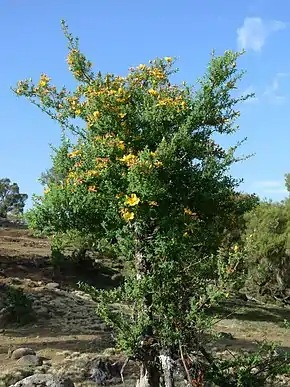Hypericum revolutum
Hypericum revolutum est un buisson ou un petit arbre rattaché à la famille des Hypéricacées selon la classification phylogénétique APG III (2009)[2] ou à celle des Clusiacées selon la classification classique de Cronquist (1981)[3].
Hypericum revolutum

Fleur d’Hypericum revolutum
| Règne | Plantae |
|---|---|
| Sous-règne | Tracheobionta |
| Division | Magnoliophyta |
| Classe | Magnoliopsida |
| Sous-classe | Dilleniidae |
| Ordre | Theales |
| Famille | Clusiaceae |
| Genre | Hypericum |
| Ordre | Malpighiales |
|---|---|
| Famille | Hypericaceae |
Il pousse le long des cours d'eau dans les prairies de montagne, entre 1 400 et 2 600 m d'altitude.
Il pousse dans l'est et le sud de l'Afrique, à Madagascar, aux Comores et à La Réunion.
Synonymes
- Hypericum kalmii Forssk.
- Hypericum lanceolatum Lam.
- Hypericum leucoptychodes Steud. ex A. Rich
Galerie
 Fleur
Fleur
Liens externes
- (en) Référence IPNI : Hypericum revolutum
- (en) Référence BioLib : Hypericum revolutum Vahl
- (en) Référence JSTOR Plants : Hypericum revolutum Vahl subsp. Vahl
- (en) Référence NCBI : Hypericum revolutum (taxons inclus)
- (en) Référence GRIN : espèce Hypericum revolutum Vahl
- Référence African plants - A Photo Guide : Hypericum revolutum (en)
- Portail de la botanique
- IPNI. International Plant Names Index. Published on the Internet http://www.ipni.org, The Royal Botanic Gardens, Kew, Harvard University Herbaria & Libraries and Australian National Botanic Gardens., consulté le 13 juillet 2020
- (en) Angiosperm Phylogeny Group, « An update of the Angiosperm Phylogeny Group classification for the orders and families of flowering plants: APG III », Botanical Journal of the Linnean Society, Wiley-Blackwell, Linnean Society of London et OUP, vol. 161, no 2, , p. 105–121 (ISSN 0024-4074 et 1095-8339, DOI 10.1111/J.1095-8339.2009.00996.X)
- (en) Arthur Cronquist, An Integrated System of Classification of Flowering Plants, New York, Columbia University Press, (ISBN 0-231-03880-1, OCLC 1136076363, lire en ligne)
Cet article est issu de Wikipedia. Le texte est sous licence Creative Commons - Attribution - Partage dans les Mêmes. Des conditions supplémentaires peuvent s'appliquer aux fichiers multimédias.